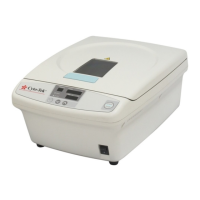1. INTRODUCTION
Page 3
1.1 Intended Use
The Cyto-Tek
®
2500 Cytocentrifuge is designed for the
purpose of transferring cells onto a glass slide from
cytological specimens contained in a specimen chamber
through the process of centrifugation. The instrument, as
part of the cytology process, is intended to facilitate the in
vitro examination of human and animal cells for morphology
changes by a cytopathologist.
1.2 General Description
The Cyto-Tek 2500 Cytocentrifuge (Figure 1A) is a self-
contained instrument designed to transfer cells from
suspension onto a glass slide by cytocentrifugation. This
instrument has the capacity for up to 12 specimen holders.
Each specimen holder will accommodate a specimen of up
to 12 mL. A mono-layer of cells from the specimen is
deposited on a glass slide in a specific, square area;
therefore, screening of the slide is simplified.
This instrument ensures specimen integrity through
automatic, paced controlled optimal acceleration. The rotor
speed is programmable in 10-rpm increments from 200 rpm
to 2500 rpm. Centrifugation times are programmable from
1 second to 99 minutes 59 seconds. The software can store
up to 30 programs.
The ON-OFF switch, control panel, and digital displays are
all located on the front of the instrument for easy access.
The Cyto-Tek 2500 was designed with enhanced features
focusing on user safety, including a new sealable rotor
housing with lid which significantly reduces aerosol
exposure. The rotor housing is completely removable and
transportable, which enable loading and unloading
specimens away from the cytocentrifuge. The Cyto-Tek
2500 Cytocentrifuge is designed for years of reliable,
efficient, smooth, and quiet operation.
1.3 Physical Characteristics
1.3.1 Components and Figures
(Figure 1B)
The components of the Cyto-Tek 2500 Cytocentrifuge are
shown and described in the following figures and
paragraphs. Read and review them carefully. Locate and
identify each component of this instrument before
attempting to install, program, and operate it.
⑨

